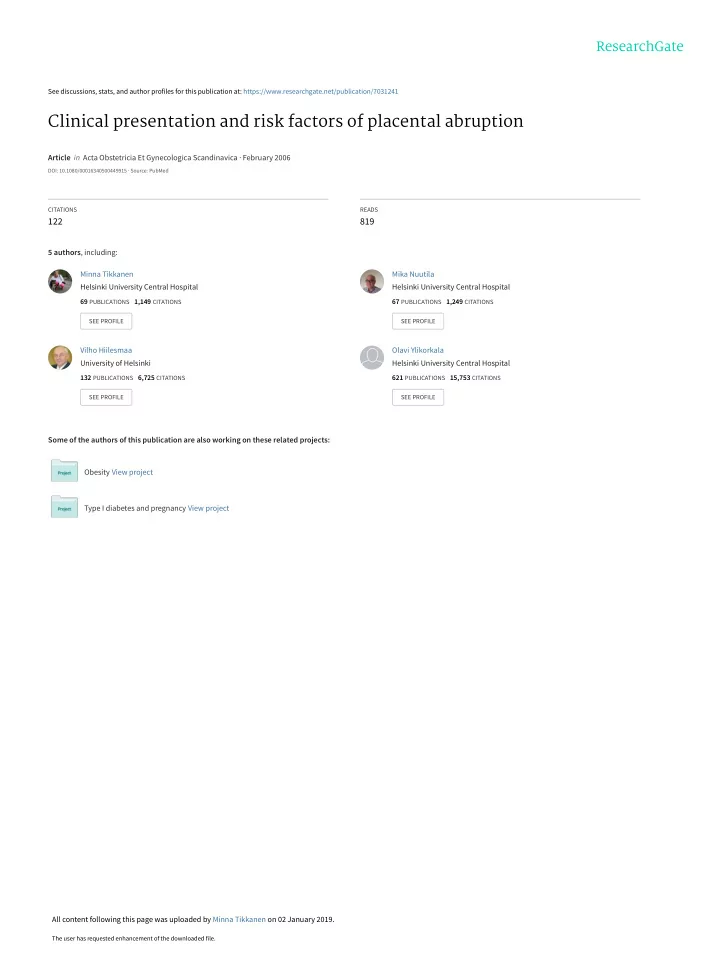

See discussions, stats, and author profiles for this publication at: https://www.researchgate.net/publication/7031241 Clinical presentation and risk factors of placental abruption Article in Acta Obstetricia Et Gynecologica Scandinavica · February 2006 DOI: 10.1080/00016340500449915 · Source: PubMed CITATIONS READS 122 819 5 authors , including: Minna Tikkanen Mika Nuutila Helsinki University Central Hospital Helsinki University Central Hospital 69 PUBLICATIONS 1,149 CITATIONS 67 PUBLICATIONS 1,249 CITATIONS SEE PROFILE SEE PROFILE Vilho Hiilesmaa Olavi Ylikorkala University of Helsinki Helsinki University Central Hospital 132 PUBLICATIONS 6,725 CITATIONS 621 PUBLICATIONS 15,753 CITATIONS SEE PROFILE SEE PROFILE Some of the authors of this publication are also working on these related projects: Obesity View project Type I diabetes and pregnancy View project All content following this page was uploaded by Minna Tikkanen on 02 January 2019. The user has requested enhancement of the downloaded file.
Acta Obstetricia et Gynecologica. 2006; 85: 700 � 705 ORIGINAL ARTICLE Clinical presentation and risk factors of placental abruption MINNA TIKKANEN, MIKA NUUTILA, VILHO HIILESMAA, JORMA PAAVONEN & OLAVI YLIKORKALA Department of Obstetrics and Gynecology, University Central Hospital, Helsinki, Finland Abstract Background. To study the risk factors of placental abruption during the index pregnancy. Methods. One hundred and ninety- eight women with placental abruption and 396 control women were identified among 46,742 women who delivered at a tertiary referral university hospital between 1997 and 2001. Clinical variables were compared between the groups. Multivariate logistic regression analysis was applied to identify independent risk factors. The clinical manifestations of placental abruption were also studied. Results. The overall incidence of placental abruption was 0.42%. The independent risk factors were maternal (adjusted OR 1.8; 95% CI 1.1, 2.9) and paternal smoking (2.2; 1.3, 3.6), use of alcohol (2.2; 1.1, 4.4), placenta previa (5.7; 1.4, 23.1), pre-eclampsia (2.7; 1.3, 5.6), and chorioamnionitis (3.3; 1.0, 10.0). Vaginal bleeding (70%), abdominal pain (51%), bloody amniotic fluid (50%), and fetal heart rate abnormalities (69%) were the most common manifestations. Neither bleeding nor pain was present in 19% of the cases. Overall, 59% had preterm labor (OR 12.9; 95% CI 8.3, 19.8), and 91% were delivered by cesarean section (34.7; 20.0, 60.1). Of the newborns, 25% were growth restricted. The perinatal mortality rate was 9.2% (OR 10.1; 95% CI 3.4, 30.1). Retroplacental blood clot was seen by ultrasound in 15% of the cases. Conclusions. Maternal alcohol consumption and smoking, and smoking by the partner turned out to be independent risk factors for placental abruption. Smoking by both partners multiplied the risk. The liberal use of ultrasound examination contributed little to the management of women with placental abruption. Key words: Placental abruption, placenta, risk factors Abbreviations: PPROM: preterm premature rupture of the membranes, PIH: pregnancy-induced hypertension, IUGR: intrauterine growth restriction Placental abruption, defined as the complete or abruption. In this study we wanted to define the risk partial separation of the placenta before delivery, is factors appearing during pregnancy and to describe a major cause of poor pregnancy outcome, which the clinical manifestations of placental abruption at often requires an emergency cesarean section and the time when ultrasound examination is routinely intensive care of the newborn. Although the classic used in obstetrical practice. symptoms of placental abruption have been well described, the signs and symptoms may vary con- Methods siderably (1). In recent studies the incidence of We sought all patients with a diagnosis of placental placental abruption has been 0.5 � 0.6% (2 � 4). The abruption (ICD-10 O45.0, O45.8, O45.9) among a rates have been increasing in many countries (5 � 8). total of 46,742 deliveries during 1997 � 2001 in our We have previously reported the sociodemo- university hospital which serves a population of graphic and historic risk factors for placental abrup- 1.2 million. Women delivering after 22 weeks of tion, i.e. risk factors preceding the index pregnancy gestation or having a newborn weighing more than (8). These included smoking, uterine malformation, 500 g were included in the analyses. The duration of history of cesarean section, and history of placental Correspondence: Olavi Ylikorkala, Department of Obstetrics and Gynecology, University Central Hospital, 00029 Helsinki, Finland. E-mail: olavi.ylikorkala@hus.fi (Received 7 June 2005; accepted 28 October 2005) ISSN 0001-6349 print/ISSN 1600-0412 online # 2006 Taylor & Francis DOI: 10.1080/00016340500449915
Recommend
More recommend